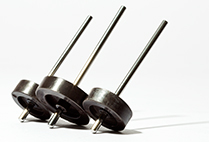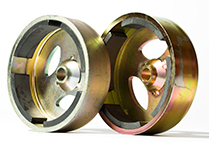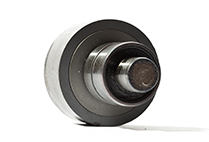To Build The Best Products, Some Assemblies Required.
Bunting-DuBois offers customers turnkey solutions for magnetic assemblies, each designed and built around our core magnets. With all of our projects – from a two-piece assembly to a complex product that demands precision design – Bunting-DuBois strives to meet your exact requirements and complete projects that will reduce cost drivers and develop a repeatable manufacturing process. Plus, we can work with you on your lean manufacturing replenishment program (JIT, Kanban, Dock-to-Stock, etc.) to ensure your parts are always available when you need them.
Bunting-DuBois can design the assembly, source the magnetic material, integrate the manufacture of the magnet and assembly, coat it, glue it, magnetize it, package it and ship it, all on time and within budget. Our interdisciplinary capabilities make Bunting-DuBois the ideal choice for the design, engineering, prototyping and manufacturing of magnetic assemblies – right here in the United States.



Magnetic Assembly Design & Engineering
Our engineering, design team provides consulting to create well-designed, flawlessly manufactured permanent magnets or a complete magnetic assembly specific to your application. Our rapid prototyping capability combined with our quick distribution facilitates a streamlined production process, no matter how complex the project is. Learn More
Bunting-DuBois manufactures sub-system magnetic assemblies for many applications at our facility in DuBois, Pennsylvania. We offer magnet manufacturing, local sourcing of metal and plastic components, as well as magnet machining, assembly, inspection, testing, final documentation, stocking and traceability.
As magnet technology becomes more advanced, so must the technology used to fully optimize the magnetic circuitry or design. By combining our expertise in all types of permanent magnet manufacturing and our extensive knowledge of CNC machining, precision metal parts and injection molded plastic work, along with complete automation, magnetizing and packaging capabilities, we offer a high-quality, cost-effective solution to all your magnetic assembly needs. With manufacturing plants in Europe and North America, plus manufacturing partners in low-cost areas around the world, Bunting-DuBois offers you the greatest value with the least worry.
Some applications for magnetic assemblies are:
- Rotors for Brushless DC (BLDC) Motors and Generators
- Magnet Systems for Medical Applications
- Magnet Systems for Sensors
Our Manufacturing Capabilities
We design and manufacture our magnetic assemblies through numerous production routes, including sintering, extrusion, calendaring, compression bonding and injection molding. Our North American facility is ISO 9001:2015 certified, and ITAR registered. We can manufacture as few as 200 or as many as 2,000,000 pieces or more per month. Learn More
Capabilities include:
- Injection and compression molded magnet materials
- Injection molded plastic materials
- Design, modeling and prototyping of assemblies
- Fabrication of any quantity, short or long run
- Integrated molding of magnetic material and assembly material
- CNC machining
- Metalwork
- Coating
- Joining
- Magnetizing
- Packaging
Fast Distribution Network
Our facility’s location in Pennsylvania means our North American customers receive their products at lower freight costs with quick turn-around times. We will work with your lean replenishment programs, employing JIT, Kanban, Dock-to-Stock, and other distribution methods to ensure your magnetic assemblies arrive on time. Learn More
Magnetic Assembly Features
- Designed with a variety of magnet materials—Neodymium Iron Boron (NdFeB), Alnico, Ceramic Ferrite, and Samarium Cobalt.
- Capabilities span from small volume needs to multiple large volume orders that must be consistently produced and on-time
- Can meet any demanding need or application, including those in automotive & transportation, medical, and aerospace & defense
- Expert team of engineers promises the right solutions, the best materials and affordability
- All-new assemblies or reverse engineering to improve your current product
- Quality and Fit Guaranteed, including glove box clean air assembly for medical devices
Common Applications for Our Magnetic Assemblies
- Appliances
- Robotics
- Transportation
- Motors & Braking Systems
- Security & Anti-Theft Devices
- Medical Devices
- Power Tools
- Agricultural Equipment
- Aerospace and Defense
- Navigational Equipment
Considerations for Engineering Magnetic Assemblies
Bunting-DuBois engineers take the following into consideration with every project to ensure the assembly meets your expectations for safety, quality and usability.
Affixing Magnets to Housings
Magnets can be successfully affixed to housings using adhesives. Some adhesives are rated to temperatures up to 180°C with fast cure times. Adhesives with higher temperature ratings are also available, but these require oven curing and fixturing of the magnets to hold them in a vacuum which takes more assembly time. Potential outgassing of the adhesives is considered.
Mechanical Fastening
When multiple magnets are assembled, especially when the magnets are placed in repelling positions, we carefully consider safety issues. Modern magnet materials such as Neodymium are extremely powerful, and when in repulsion they can behave as projectiles if adhesives were to break down. In these situations, we include mechanical fastening in the design in addition to adhesives. Potential methods of mechanical retention include encasement, pinning, or strapping the magnets in place with non-magnetic metal components.
Potting
Magnet assemblies may be potted to fill gaps or to cover entire arrays of magnets. Potting compounds cure to hard and durable finishes and are available to resist a variety of environments, such as elevated temperatures, water flow, etc. When cured, the potting compounds may be machined to provide accurate finished parts.
Welding
Assemblies which are required to be hermetically sealed are welded using either laser welding (which is not affected by the presence of magnetic fields) or TIG welding (using appropriate shunting elements to reduce the effect of magnetic fields on the weld arc). Special care should be taken when welding magnetic assemblies so that heat dissipation of the weld does not affect the magnets.
